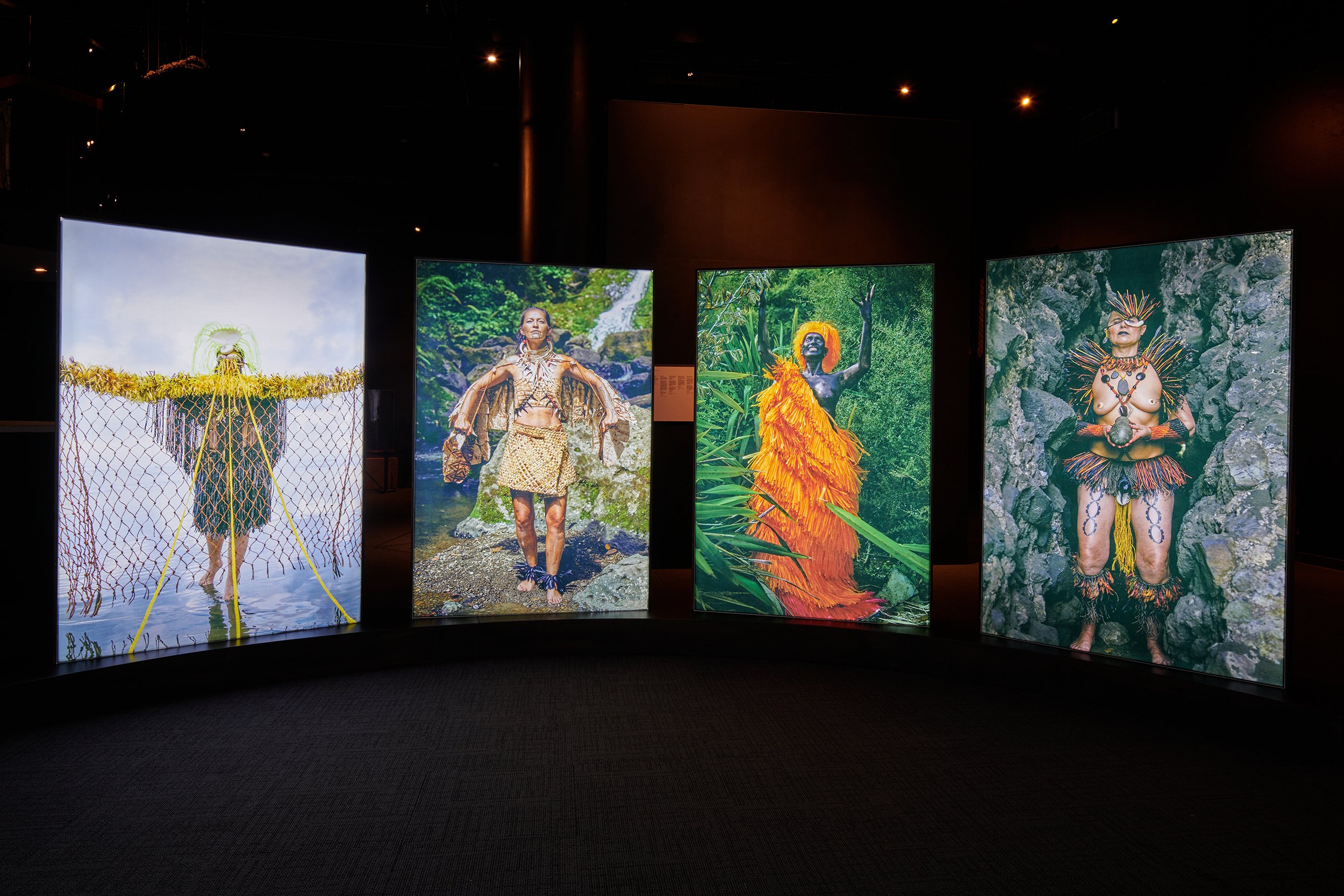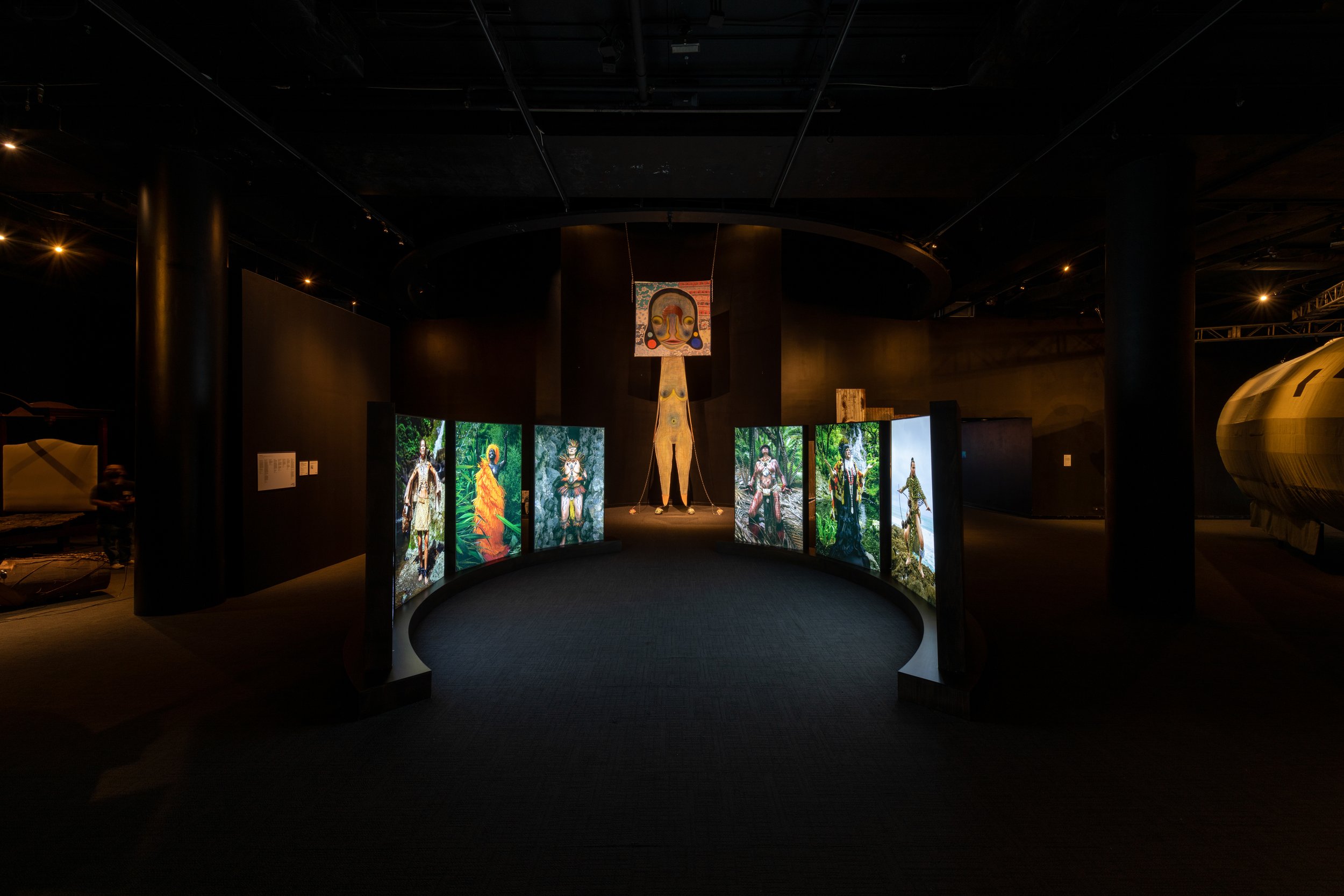hawai‘i triennial 2022
@ BISHOP MUSEUM
Pacific Sisters
Rosanna Raymond, Ema Lyon, Ani O’Neill, Feeonaa Clifton (née Wall), Salvador Brown,
Ruth Woodbury, Nephi Tupaea, and Suzanne Tamaki
Lives and works in ŌmĀpere, Tāmaki Makaurau,
Heretaunga, and Te Whanganui-a-Tara, Aotearoa
Installation views: Pacific Sisters, Te Pu o Te Wheke, 2021, photographic image on fabric, aluminum, wood, lightbox, Augmented Reality: iSPARX, Bishop Museum, HT22, Honolulu. Courtesy of the artists and Hawai‘i Contemporary. Photos: Christopher Rohrer.
The Pacific Sisters are a fluid collective of Māori, Tongan, Sāmoan, and Cook Island women, soles, and faʻafafine artists, designers, storytellers, performers, musicians, educators, and mentors. Initiated during the early 1990s at warehouse venues and on the streets of Tāmaki Makaurau, Auckland, by Selina Forsythe (née Haami), Suzanne Tamaki, and Nephi Tupaea, the group came together around their shared love for fashion, activism, and collaboration. For nearly three decades, the Pacific Sisters have been in constant and active reformation, an ever-evolving cast of family and friends including Rosanna Raymond, Ani O’Neill, Jaunnie ‘Ilolahia, Favaux Valepo, Jeanine Clarkin, Henry Ah-Foo Taripo, Feeonaa Wall, Bethany Edmunds, Selina Haami, Ema Lyon, Sofia Tekela-Smith, Karlos Quartez, Greg Semu, Lisa Reihana, Darryl Thompson (DLT), Katharine Losi, Te Miringa Hohaia, Maaka Pepene, and many others.
Bound by Moananui, the Pacific Sisters weave urban expressions of Indigeneity and channel vibrant energies of their respective cultures onto catwalks, stages, theaters, and walls in festival, club, gallery, and institutional settings. The collective has played a vital role in a number of trailblazing events, including the Pasifika festival fashion shows, with the first two in Tāmaki Makaurau—the Pasifika festival fashion show in 1993 and Bottled Ocean in 1994–95 (curated by Jim Vivieaere)—and the third staged during the 7th Festival of Pacific Arts, Tala Measina, in independent Sāmoa in 1996. Transgressing boundaries, flowing seamlessly between different spaces and times, towards a place imbued with ‘contemporary’ and ‘traditional’ materials and practices, the Sisters help to lead difficult conversations around stereotypes and expectations—both within and outside of Indigenous contexts—catalyzing long-overdue change during the process.
A collaborative method of production is essential to the fashion work of the Pacific Sisters. Frequently, multiple members will contribute to a single piece, as with 21st Sentry Cyber Sister (1997), an aitu, or avatar, commissioned for the permanent Pacific collection of Te Papa Tongarewa, Museum of New Zealand, Wellington. Constituted of twenty-seven distinct parts—made of harakeke, plastic, shells (coconut and cowrie), nylon, tapa, video tape, feathers, seeds, bone, and more—Cyber Sister was created by Suzanne Tamaki, Nephi Tupaea, Rosanna Raymond, and Ani O’Neill. This approach is carried on through three new aitu, Mururoa, Supa Suga, and TOHU TūPUNA, currently housed as part of the permanent collection in Tāmaki Paenga Hira, Auckland War Memorial Museum.
Twenty years after 21st Sentry Cyber Sister’s arrival at Te Papa, the collective had their first major mid-career retrospective at the museum, Pacific Sisters: He Toa Tāera|Fashion Activists (2018), curated by Nina Tonga. Honoring their long-standing and ongoing efforts to amplify Pacific bodies, stories, genders, garments, and expressions, the exhibition featured collaborative work in fashion, dance, film, performance, music, and photography. It also served as a testament to generations of fierce mana wāhine who have supported and continue to strengthen pathways between Pacific genealogies and geographies, across communities and institutions.
For HT22 the Pacific Sisters offer a grouping of eight full-body portraits produced in close collaboration with photographer Pati Tyrell. Each image, presented as a lightbox and activated through augmented reality developed by iSPAR, depicts a different aitu. Standing in a semicircle, their aitu addresses the foundational question, ‘Who are you?’ Within the darkness of Castle Building at Bishop Museum, representations of their individual and collective powers, narratives, sounds, and appearances glow bright. Future ancestors shine in the present—may the rebellious and playful spirits of the Pacific Sisters continue to invoke and inspire many, especially Moananui’s younger generations of fashion activists.
Courtesy of the artists.
Pacific Sisters is a group of New Zealand fashion designers, artists, performers, and musicians who began working together in the early 1990s, the members of predominantly mixed Polynesian and European heritage. A significant early catalyst of the group was living in Auckland’s multicultural metropolis, in particular within the world’s largest urban population of different Pacific peoples.
Initially at the fringes, their work forged a pathway into the mainstream popular culture environment of New Zealand, later gaining recognition within International Arts Festivals. Pacific Sisters entry connected to a new wave of urban Pacific arts and cultural expression concerned with exploring the juxtaposition of different Pacific identities in an urban environment.Their work continues to re-contextualise the wisdom and knowledge of the Pacific in an urban domain, exposing the role of Pacific values in contemporary society, in a celebration of commonality and diversity that affirms the relevance of Pacific culture for the future.






